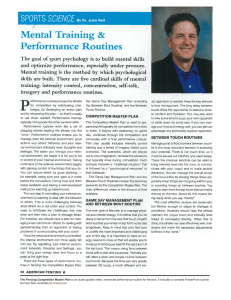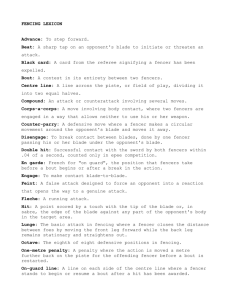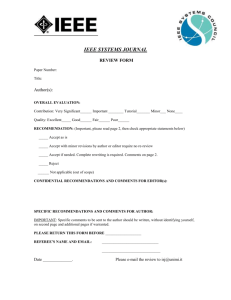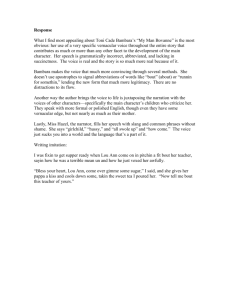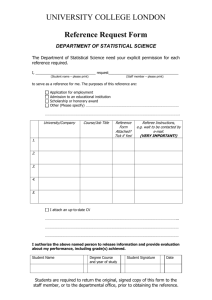Conduct of bouts
advertisement
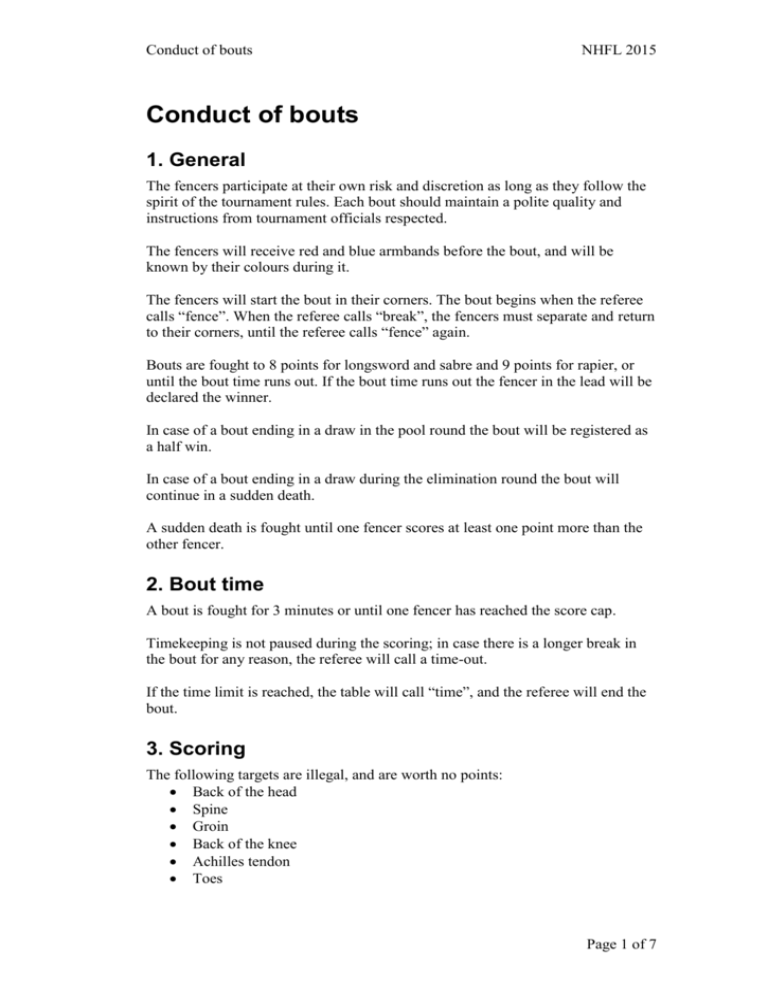
Conduct of bouts NHFL 2015 Conduct of bouts 1. General The fencers participate at their own risk and discretion as long as they follow the spirit of the tournament rules. Each bout should maintain a polite quality and instructions from tournament officials respected. The fencers will receive red and blue armbands before the bout, and will be known by their colours during it. The fencers will start the bout in their corners. The bout begins when the referee calls “fence”. When the referee calls “break”, the fencers must separate and return to their corners, until the referee calls “fence” again. Bouts are fought to 8 points for longsword and sabre and 9 points for rapier, or until the bout time runs out. If the bout time runs out the fencer in the lead will be declared the winner. In case of a bout ending in a draw in the pool round the bout will be registered as a half win. In case of a bout ending in a draw during the elimination round the bout will continue in a sudden death. A sudden death is fought until one fencer scores at least one point more than the other fencer. 2. Bout time A bout is fought for 3 minutes or until one fencer has reached the score cap. Timekeeping is not paused during the scoring; in case there is a longer break in the bout for any reason, the referee will call a time-out. If the time limit is reached, the table will call “time”, and the referee will end the bout. 3. Scoring The following targets are illegal, and are worth no points: Back of the head Spine Groin Back of the knee Achilles tendon Toes Page 1 of 7 Conduct of bouts NHFL 2015 If the point limit is reached, the table will call “match”, and the referee will end the match. After this the table will announce the score to the referee, who will officially announce the winner of the match and the final score. 3.1 Scoring with longsword or sabre For longsword, only attacks with the edge, point or pommel score points. Strikes with the crossguard are not allowed. All strikes must be executed in a controlled fashion. For sabre, only attacks with the true edge, point or guard score points. All strikes must be executed in a controlled fashion. A strike to the head (i.e. a strike with cut with the blade or a thrust) above the level of the chin is worth 2 points A thrust to the torso is worth 2 points All other legal targets and pommel strikes are worth 1 point Any strike made outside grappling with only one hand holding the sword is worth 1 point, no matter what target is hit (only for longsword) At the first hit, a judge will call “point”. After giving time for an after-blow, the referee will call “break”. When “break” is called, the fencers must cease attacking, separate, and return to their corners. After this, the referee will call “judges”. Each judge will indicate the highest scoring blow for each fencer that happened within one tempo of the initial hit. This means that if the fencer who struck first can hit a higher-scoring target within one tempo, this hit is valid. The semaphore is as follows: Hit on 2 points target: Judge holds the flag vertically up Hit on 1 point target: Judge holds the flag horizontally sideways No hit: Judge holds the flag low, crossed in front of his body Each fencer will score as follows: If two judges agree on the score, the fencer scores that amount. If two judges agree on hit, but disagree on the score, the lower score is awarded. If all three judges agree on hit, but disagree on score, the majority score is awarded. The referee announces the points for both fencers to the scorekeeper. The scorekeeper then subtracts the lower score from the higher score, and announces the final score. To clarify: after-blows and simultaneous hits are treated the same and both can score regardless of who struck first. The hits from both fencers are scored independently by the judges; the scorekeeper is responsible for calculating the final score of the exchange. Page 2 of 7 Conduct of bouts NHFL 2015 Incidental strikes, cuts with questionable edge alignment, very light cuts with the point and cuts made with a very small arc does not score. It is up to the fencers to demonstrate “good” hits. Only indicating attacks with sword or body due to safety reasons will still score. For example indicating a strike to the back of the head during a grappling situation. 3.2 Scoring with rapier Only attacks with the edge, point or pommel score points. All strikes must be executed in a controlled fashion. A rapier/dagger strike to the head above the level of the chin is worth 3 points A rapier/dagger thrust to the torso is worth 3 points All other legal targets are worth 1 point At the first hit, a judge will call “point”. After giving time for an after-blow, the referee will call “break”. When “break” is called, the fencers must cease attacking, separate, and return to their corners. After this, the referee will call “judges”. Each judge will indicate the highest scoring blow for each fencer that happened within one tempo of the initial hit. This means that if the fencer who struck first can hit a higher-scoring target within one tempo, this hit is valid. The semaphore is as follows: Hit on 3 points target: Judge holds the flag vertically up Hit on 1 point target: Judge holds the flag horizontally sideways No hit: Judge holds the flag low, crossed in front of his body Each fencer will score as follows: If two judges agree on the score, the fencer scores that amount. If two judges agree on hit, but disagree on the score, the lower score is awarded. If all three judges agree on hit, but disagree on score, the majority score is awarded. The referee announces the points for both fencers to the scorekeeper. The scorekeeper then subtracts the lower score from the higher score, and announces the final score. To clarify: after-blows and simultaneous hits are treated the same and both can score regardless of who struck first. The hits from both fencers are scored independently by the judges; the scorekeeper is responsible for calculating the final score of the exchange. Incidental strikes, cuts with questionable edge alignment, very light cuts with the point and cuts made with a very small arc does not score. It is up to the fencers to demonstrate “good” hits. Page 3 of 7 Conduct of bouts NHFL 2015 In particular, judges are looking for cuts to “slice”, that is for the debolé of the sword to move across the target area (pushed or pulled), with positive pressure onto the target. “Percussive” cuts may be scored if: • They are properly controlled • The sword rotates at least ¼ circle • The sword does not “bounce” off the target • Thrusts must fix the point onto the target with positive pressure Only indicating attacks with sword or body due to safety reasons will still score. For example indicating a strike to the back of the head during a grappling situation. 3.3 Scoring during grappling In a grappling situation, a fencer can score by striking with the weapon(s), by using grappling actions or by demonstrating dominance. These special situations are scored by the referee alone; the judges only score strikes with the sword. The referee will halt the action in case of a judge calling “point”, if there is a scoring grappling technique, if one fencer demonstrates dominance, if the referee thinks there is a safety issue or if the grappling is at stalemate (ca 5 seconds without anything happening) Grabbing and maintaining a hold on a stationary sword is allowed. The following techniques score 1 point in grappling: If a fencer pushes both feet of his opponent outside the mat, and remains inside with at least one foot. Likewise, if a fencer accidentally leaves the mat with both feet, his opponent is awarded 1 point. Strikes with the sword by a fencer outside the arena do not score, while strikes with the sword against a fencer outside the arena do score as normal. For Copenhagen Open, takedowns are disallowed and will result in a warning. The following is only applicable for Örebro Open: If a fencer uses a takedown placing any part of the opponent other than the feet on the mat. Likewise, if a fencer should fall on his own, his opponent is awarded 1 point. Going down on one knee or touching the mat with one hand outside grappling does not award the opponent any points. Takedowns intended to land the opponent on their head are not allowed. If a fencer demonstrates dominance by using hands, elbows, knees, feet or head in an offensive manner. Scoring by grappling is secondary to scoring with strikes of the sword. If a fencer is struck with a sword while executing a grappling technique, only the strike with the sword will score. Page 4 of 7 Conduct of bouts NHFL 2015 4. Protests – Örebro Open only Fencers and coaches may oppose the judges’ point decisions once per match. If the opposition is approved the right for further complaints has not been forfeited. Other protests, for example regarding illegal techniques, have no upper limit. The complaint is always referred to the referee. To call for attention the fencer or coach calls out “Protest!” The referee will then approach the fencer to get the fencer’s view of the situation. The fencer or coach is only allowed to make his/her opinion known to the referee, and is not allowed to voice his/her opinion so that the judges hear it and are influenced by it. If the protest is made in such a way, it will be deemed invalid. The referee will then gather the judges and ask them what they saw. The relevant issue is judge placement and judge focus level. The protest is not meant to be used as a tool to award a fencer unclear hits, only to minimize the effect of clear mistakes. The referee should be restrictive in changing the score and only do so when for example one judge in a good position saw a very clear hit that was missed by judges in a poor position, or a head hit that was judges as an arm hit. This mechanism is not meant to make sure all calls are correct, but to deal with blatant mistakes, caused by judge placement, or administrative errors, such as the wrong flag being raised or the flags being wrongly counted. If protests are used without just cause the protester will be penalized. 5. Errors and penalties Each bout should be conducted in a safe and respectful manor. The penalties for errors against these guidelines are: Warning Penalty hit Disqualification The referee will rule according to the tables below. Format of the bout First time Not present during bout call Non regulatory equipment Leave the mat without permission Addressing the referee before the final score for the exchange is announced Unwarranted suspension of the bout Protest deemed unjustified Request of suspension of the bout due to Warning Warning Warning Warning Second and following times Penalty hit Penalty hit Penalty hit Penalty hit Warning Warning Penalty hit Penalty hit Penalty hit Penalty hit Page 5 of 7 Conduct of bouts NHFL 2015 injury that is not accepted Safety First time Turn the back to the opponent before the referee called “break” Take the mask off before the referee called “break” Striking after the referee called “break” Uncontrolled fencing Violent, dangerous or vindictive action Intentional brutality Warning Second and following times Penalty hit Warning Penalty hit Warning Warning Penalty hit Disqualification Penalty hit Penalty hit Penalty hit Sportsmanship First time Second and following times Penalty hit Disqualification Refusal to obey the referee Warning Refusal to salute the opponent before the Warning bout Refusal to salute the opponent after the Warning Disqualification bout Refusal to face contestant that is duly Warning Disqualification registered Person that interferes with the order on Warning Disqualification the mat To favour the opponent or benefit from Disqualification unauthorized agreements Violation against sportsman spirit Disqualification A warning is valid for the bout at hand. If a fencer commit an error that should result in a warning after already have received a warning the opponent receives 1 point regardless of which the second error is. Each warning is recorded in the bout protocol. If a fencer, coach or member of the audience is disqualified he or she must leave the premises immediately. Violation against the sportsman spirit includes, but is not limited to, using foul language, throwing equipment and threatening tournament officials. 5. Injuries If a fencer is injured during the bout, the referee will call a time-out and the medical staff will examine the fencer. If the medical staff clears the fencer to continue, and the fencer wishes to do so, the bout can proceed. If the bout cannot continue within 3 minutes the injured fencer will have forfeited the bout. Page 6 of 7 Conduct of bouts NHFL 2015 6. Equipment failure The referee will call a time-out when equipment being broken or displaced is noticed. If a fencer or judge notices an equipment failure, they should point it out to the referee. If a piece of personal protective gear is broken, the fencer has 3 minute to find a replacement. If this is not possible the fencer will have forfeited the bout. Page 7 of 7
